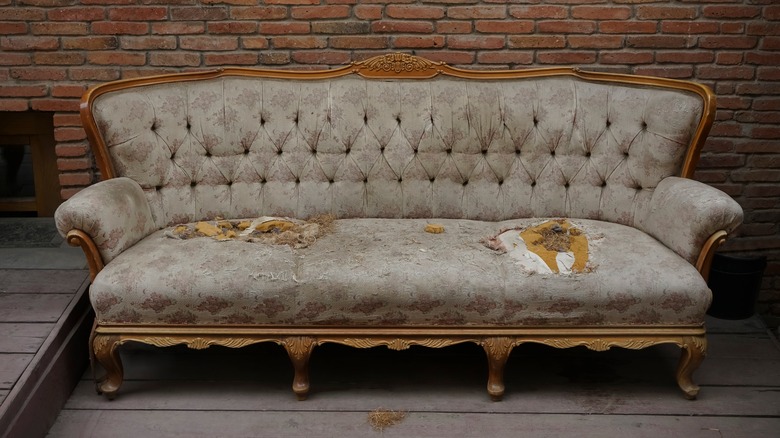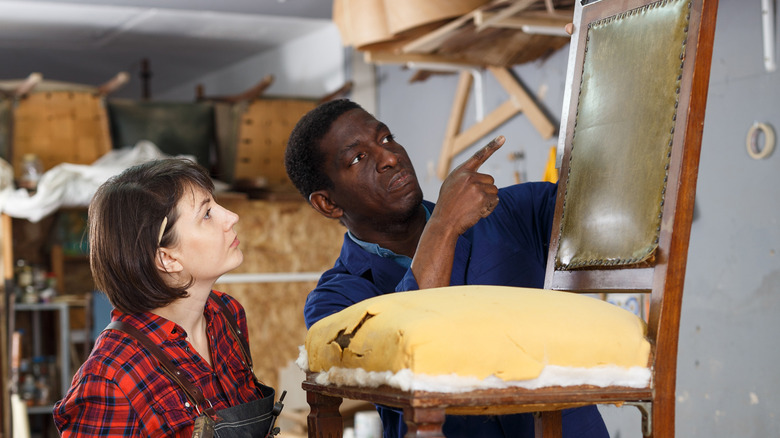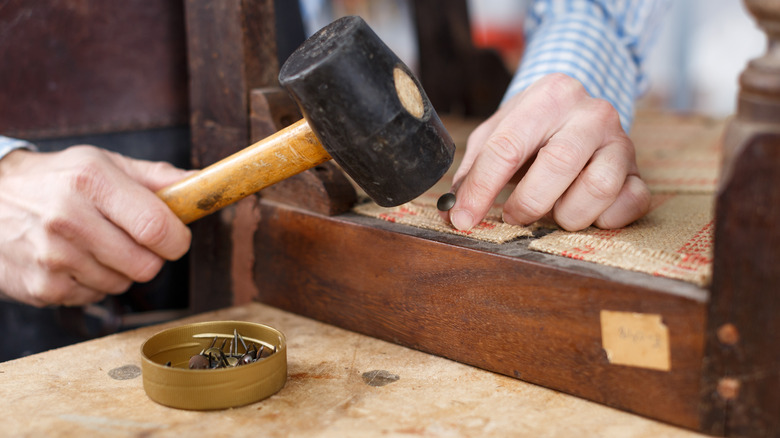What To Consider Before Reupholstering Vintage Furniture
Reupholstering vintage chairs and sofas can make a big difference to your space, but it's definitely not something to try on a whim. Quite the contrary, from the value of the fabric to how reupholstery could impact the rest of the frame, there are a few things to keep in mind before you consider taking the plunge.
First things first, it's important to think about why you want to reupholster your vintage chair or sofa. If the original upholstery is badly damaged in some way, go right ahead. After all, damaged fabric isn't going to do much for the piece's value. Having said that, if the damage is minor and you think the fabric could be salvaged, it's definitely advisable to do some research on the item — and if the upholstery isn't damaged at all, and you simply want to bring in a blend of old and new into your home ... well, research becomes even more important.
As noted by Carrocel Interiors, reupholstery (unless it's necessary) can negatively impact the resale value of a vintage piece. That's particularly true if the piece in question is valuable in its original form. For that reason, before making any decisions based solely on wanting a newer-looking piece, it's a good idea to look into who manufactured the piece, way back when.
Check for any signs that the original material is unique
If you're considering reupholstering a vintage piece of furniture, always be sure to check who designed the original fabric first. Per Carrocel Interiors, in some instances, the upholstery itself was incredibly valuable at the time of its manufacture. That would make it even more valuable today.
As for how to tell out if the fabric on your vintage or antique furniture fits the bill, you could look for signs from the manufacturer yourself. According to Paolo Moschino, you may be able to spot a label, or find signs of the manufacturer burned into the wood. However, because these logos were often behind the upholstery, or may even have worn off in time, it's highly advisable to get the pieces appraised by a professional who knows exactly what to look for. Your local antique shop or auctioneer will typically do this, so take a look at who is available in your area.
Once you know whether there is any value in the original upholstery, you can make an informed decision on how to move forward. Having said that, it is worth noting that even if a chair doesn't hold a ton of value, financially, there is value in the history of the piece. For that reason, Hoarde Vintage recommends considering putting the pieces on the market if they are salvageable in their original form, unless you're particularly attached to them.
If you are going to reupholster, call a professional
If the original upholstery of your vintage furniture isn't valuable, but you do want to keep and spruce up the chairs, reupholstery is an option. Once again, though, you do need to proceed with caution. Even if you've never shied from a DIY in the past and think you can try your hand at it, remind yourself that the idea of reupholstering being easy is a myth, and enlist the help of a professional.
As noted by Hoarde Vintage, trying to reupholster vintage furniture without the relevant tools and know-how could easily end up damaging the structure of the piece. That's obviously not ideal — especially if you're reupholstering because you love the chair or sofa itself, or because it was handed down through another family member. To avoid any potential mishaps, look into upholsterers who have experience working with antiques. There is a possibility it will cost more, but if that's a major concern, it's safer to save up and reupholster at a later stage.
Ultimately, whether or not you decide to reupholster your vintage furniture is a personal decision. There are certainly merits to keeping them in their original form, if possible — but if new upholstery lets you make your own mark on a piece of history, that's pretty special, too.


